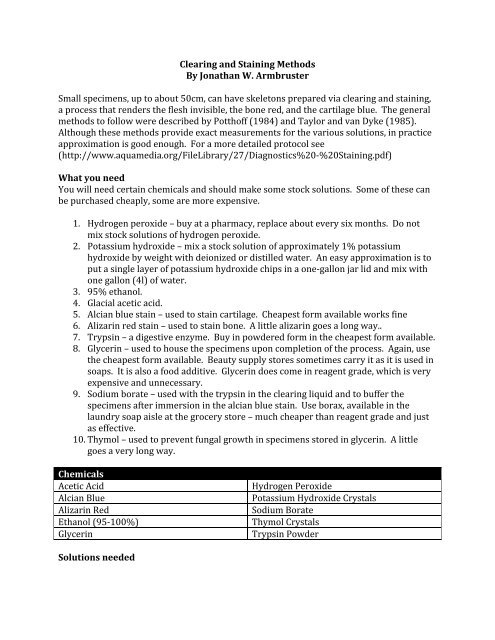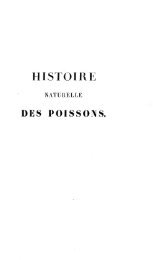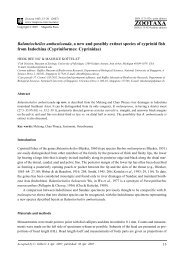Clearing and Staining Methods By Jonathan W. Armbruster Small ...
Clearing and Staining Methods By Jonathan W. Armbruster Small ...
Clearing and Staining Methods By Jonathan W. Armbruster Small ...
Create successful ePaper yourself
Turn your PDF publications into a flip-book with our unique Google optimized e-Paper software.
<strong>Clearing</strong> <strong>and</strong> <strong>Staining</strong> <strong>Methods</strong><br />
<strong>By</strong> <strong>Jonathan</strong> W. <strong>Armbruster</strong><br />
<strong>Small</strong> specimens, up to about 50cm, can have skeletons prepared via clearing <strong>and</strong> staining,<br />
a process that renders the flesh invisible, the bone red, <strong>and</strong> the cartilage blue. The general<br />
methods to follow were described by Potthoff (1984) <strong>and</strong> Taylor <strong>and</strong> van Dyke (1985).<br />
Although these methods provide exact measurements for the various solutions, in practice<br />
approximation is good enough. For a more detailed protocol see<br />
(http://www.aquamedia.org/FileLibrary/27/Diagnostics%20-‐%20<strong>Staining</strong>.pdf)<br />
What you need<br />
You will need certain chemicals <strong>and</strong> should make some stock solutions. Some of these can<br />
be purchased cheaply, some are more expensive.<br />
1. Hydrogen peroxide – buy at a pharmacy, replace about every six months. Do not<br />
mix stock solutions of hydrogen peroxide.<br />
2. Potassium hydroxide – mix a stock solution of approximately 1% potassium<br />
hydroxide by weight with deionized or distilled water. An easy approximation is to<br />
put a single layer of potassium hydroxide chips in a one-‐gallon jar lid <strong>and</strong> mix with<br />
one gallon (4l) of water.<br />
3. 95% ethanol.<br />
4. Glacial acetic acid.<br />
5. Alcian blue stain – used to stain cartilage. Cheapest form available works fine<br />
6. Alizarin red stain – used to stain bone. A little alizarin goes a long way..<br />
7. Trypsin – a digestive enzyme. Buy in powdered form in the cheapest form available.<br />
8. Glycerin – used to house the specimens upon completion of the process. Again, use<br />
the cheapest form available. Beauty supply stores sometimes carry it as it is used in<br />
soaps. It is also a food additive. Glycerin does come in reagent grade, which is very<br />
expensive <strong>and</strong> unnecessary.<br />
9. Sodium borate – used with the trypsin in the clearing liquid <strong>and</strong> to buffer the<br />
specimens after immersion in the alcian blue stain. Use borax, available in the<br />
laundry soap aisle at the grocery store – much cheaper than reagent grade <strong>and</strong> just<br />
as effective.<br />
10. Thymol – used to prevent fungal growth in specimens stored in glycerin. A little<br />
goes a very long way.<br />
Chemicals<br />
Acetic Acid Hydrogen Peroxide<br />
Alcian Blue Potassium Hydroxide Crystals<br />
Alizarin Red Sodium Borate<br />
Ethanol (95-‐100%) Thymol Crystals<br />
Glycerin Trypsin Powder<br />
Solutions needed
1. 15% hydrogen peroxide/85% Potassium hydroxide – mix as needed (I often do this<br />
in the jar).<br />
2. 30% acetic acid/70% ethanol/alcian blue – mix liquids <strong>and</strong> then add enough alcian<br />
blue to make a deep blue liquid. You may reuse this solution many times. When the<br />
alcian blue no longer stays in solution, replace.<br />
3. Staurated sodium borate – add a lot to a jar of deionized water <strong>and</strong> shake<br />
vigorously. Let sit for awhile, shake again. Make sure that there is still sodium<br />
borate at the bottom of the jar <strong>and</strong> you have saturated sodium borate.<br />
4. 30% Sodium Borate – take your stock saturated sodium borate solution <strong>and</strong> mix it<br />
with water – 30% sodium borate solution/70% water.<br />
5. 30% sodium borate + trypsin – mix when you place specimens into trypsin. I<br />
usually add approximately ¼ teaspoon/specimen. A little less if they are small, a<br />
little more if they are large.<br />
6. 70% potassium hydroxide/30% glycerin – mix by volume. Solution can be reused<br />
unless it is too stained<br />
7. 40% potassium hydroxide/60% glycerin – as above.<br />
8. Glycerin + thymol – add a few crystals of the thymol to the glycerin solution.<br />
Alternatively, you can dissolve the thymol in alcohol so that it is saturated <strong>and</strong> add a<br />
couple of drops to the glycerin. You can store specimens in a glycerin/ethanol<br />
solution (no greater than 25% ethanol), but the specimens will not appear as clear.<br />
Chemicals<br />
10% Formalin 30% Sodium Borate<br />
Ethanol (30%, 70%. 95-‐100%) 30% Sodium Borate + Trypsin (mix as<br />
needed)<br />
15% Hydrogen Peroxide/85% Potassium 70% Potassium Hydroxide/30% Glycerin<br />
Hydroxide (mix as needed)<br />
30% Acetic Acid/70% Ethanol/Alcian Blue 40% Potassium Hydroxide/60% Glycerin<br />
Saturated Sodium Borate Glycerin + Thymol (mix as needed)<br />
Step 1, Preservation: If your fish is not preserved, preserve in 10% formalin solution for 5<br />
days, rinse with water, store in water for a couple of days, rinse again, <strong>and</strong> step up alcohol<br />
(30%, 70%) with 2-‐5 days in each level depending on size (
Step 4, Alcian Blue <strong>Staining</strong> for cartilage: Place specimens in 30% acetic acid/70%<br />
ethanol/alcian blue stain for 1 day (500 mm).<br />
Step 5, Neutralization: Return alcian blue stain solution to stock bottle, <strong>and</strong> place<br />
specimens in saturated sodium borate for half a day (100 mm; you<br />
may wish to change solution halfway through).<br />
Step 6, Bleaching: Place specimens in 15% hydrogen peroxide/85% potassium hydroxide<br />
solution. Most specimens will be depigmented within an hour (darker specimens may take<br />
a little longer). If the specimen has little pigment, you may skip this step. DO NOT LEAVE<br />
SPECIMENS TOO LONG IN THIS SOLUTION!<br />
Step 7, <strong>Clearing</strong> 1: Place specimens in 30% sodium borate solution <strong>and</strong> add approximately<br />
¼ teaspoon of trypsin per specimen (if you are clearing a lot in a jar at the same time, you<br />
can add less). You may need to change this solution in a couple of days if it turns blue.<br />
Replace solution every 7-‐10 days until the specimen is about 60% clear (you can see the<br />
bones of the vertebral column, but it isn’t perfectly clear yet). Keeping the specimens in<br />
light may speed the clearing process.<br />
Step 8, Alizarin <strong>Staining</strong> for Bone: Add enough alizarin red dye to 1% potassium<br />
hydroxide solution to make it a deep reddish purple. This will take only a tiny amount of<br />
alizarin (about what you can grab with a small forceps). Shake vigorously to mix. Leave<br />
specimens in until the bones reach the level of darkness that you prefer (some like lightly<br />
stained specimens <strong>and</strong> some like them almost purple). Usually 1-‐3 days is sufficient. DO<br />
NOT LEAVE SPECIMENS TOO LONG IN THIS SOLUTION!<br />
Step 9, <strong>Clearing</strong> 2: Place specimens back into trypsin solution until suitably clear. What is<br />
this? It is when the flesh seems almost invisible. It will not be perfectly clear because the<br />
clarity in glycerin is part optical illusion (the refractive index of the glycerin <strong>and</strong> the cleared<br />
flesh is about the same). Usually a week will suffice.<br />
Step 10, Stepping to Glycerin: This step is not necessary, but it helps to fix the dyes in the<br />
fish (I think) as well as prepare the tissues for full immersion in glycerin. Place specimens<br />
in stock 70% potassium hydroxide/30% glycerin for 2-‐7 days (depending on size) <strong>and</strong> then<br />
40% potassium hydroxide/60% glycerin for 2-‐7 days. Then place in glycerin with thymol<br />
for final storage.<br />
NOTE 1: Specimens that are poorly preserved may begin to fall apart at any stage<br />
during this process. If this begins to happen, rush the specimens through the<br />
procedure <strong>and</strong> avoid potassium hydroxide! Specimens will take the dye in a solution<br />
of 30% sodium borate if necessary.<br />
NOTE 2: For extremely delicate specimens, you can mix the alizarin with either<br />
sodium borate or glycerin for staining. Avoid potassium hydroxide. This will not<br />
work as well, but it will work.
NOTE 3: Old specimens rarely stain well for cartilage. If you wish to stain only bone,<br />
skip steps 3-5.<br />
Literature Cited<br />
Potthoff, T., 1984. <strong>Clearing</strong> <strong>and</strong> staining techniques. In: Moser, H.G. (Ed.), Ontog eny <strong>and</strong><br />
Systematics of Fishes. Special Publication-‐American Society of Ichthyolo gists <strong>and</strong><br />
Herpetologists, vol. 1. Allen Press, Lawrence, KS, USA, pp. 35–37.<br />
Taylor, W.R., van Dyke, G.C. (1985) Revised procedures for staining <strong>and</strong> clearing small<br />
fishes <strong>and</strong> other vertebrates for bone <strong>and</strong> cartilage study. Cybium 9: 107-‐119





